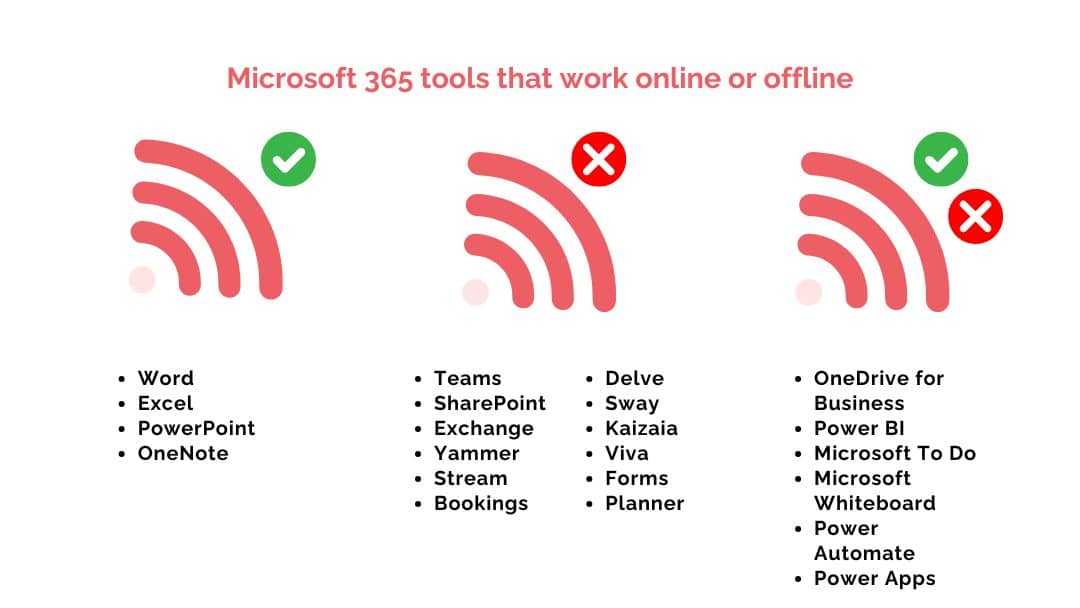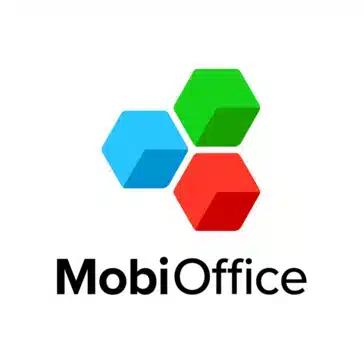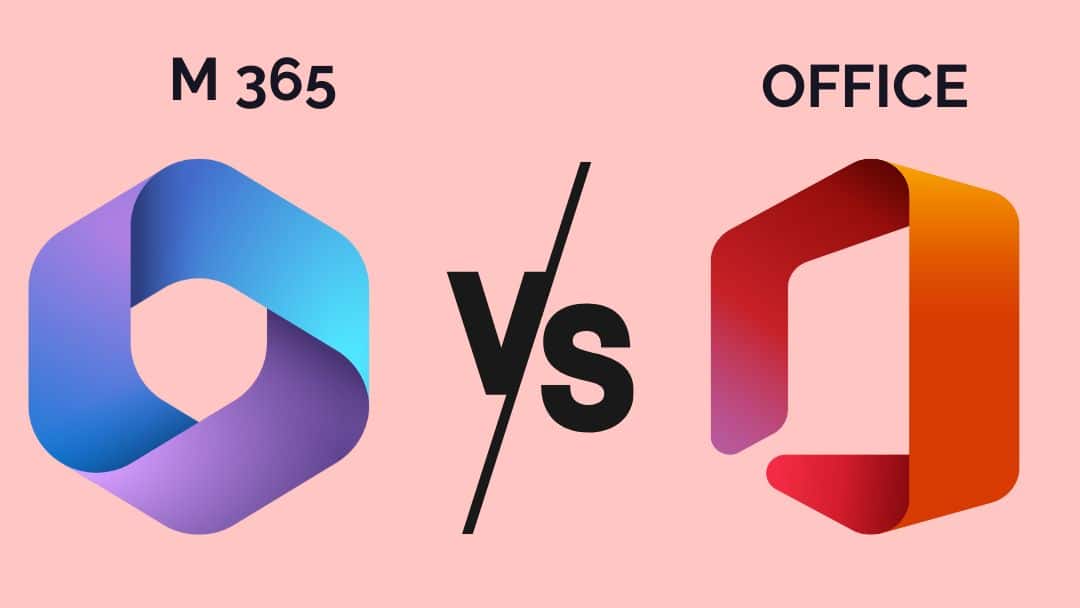At SmartYou, we’re fully convinced that IT solutions are at the service of your efficiency, and shouldn’t become a constraint.
But with so many productivity solutions out there, it’s hard to make an informed choice that really combines your needs with your budget constraints. Here’s a recurring question: which is better for your business, Microsoft Office or Microsoft 365?
We’ll go into more detail to help guide your decision, focusing on a precise, objective analysis of the two solutions. Of course, we’ll also suggest alternatives to Microsoft.
What is Microsoft 365?
According to Microsoft, it’s “a cloud-based productivity platform”.
To be more precise, we could also say that Microsoft 365 refers to a subscription that combines :
- The famous Microsoft Office suite with Word, Excel, PowerPoint, Outlook, OneNote, Publisher and Access, although the latter two are only available on PCs and not on Macs;
- A set of cloud-based online services, such as Teams, Viva Engage, Exchange Online, OneDrive and SharePoint Online ;
- Theartificial intelligence feature Copilot feature, integrated into office applications;
- Security and compliance features such as Microsoft Defender Information Rights Management (IRM) and Data Loss Prevention.
The advantage of this productivity platform is that it is continually updated to ensure that users always benefit from the latest innovations.
How does it differ from Office?
What are the differences between Microsoft 365 and Office?
Microsoft 365 is simply an evolution of Office.
From Microsoft Office to Microsoft 365
There is often confusion between these solutions. Indeed, “Microsoft Office” used to refer to versions of the office suite sold as perpetual licenses, while “Office 365” referred to the subscription-based offering, with collaboration tools, cloud services and security features. So it was relatively clear.
At present, however, three names coexist:
- “Microsoft 365” refers to subscription-based offerings.
- “Office + year” (example: Office 2021) refers to the perpetual license version of the Office suite, for a single purchase without subscription.
- “Office 365” refers only to a few subscription-based offerings aimed at large enterprises, although Microsoft has renamed most of its Office 365 offerings to Microsoft 365.
Subscription cost
For SMEs
There are 4 plans, which can be monthly or annual subscriptions, for up to 300 users. If you’re wondering which is best for your business, SmartYou can provide support tailored to your SME’s IT environment.
| Plan | Description | Price per user per month, excluding VAT |
| Business Basic | – Online Office applications (Word, Excel, PowerPoint) – Cloud services – No desktop applications | CHF 6.48 |
| Business Standard | – Business Basic options – Complete desktop applications installed on your computer | CHF 13.44 |
| Business Premium | – Business Standard options – Advanced security and management features | CHF 23.64 |
| Apps for Business | – Desktop and online Office applications – No additional services required | CHF 11.16 |
For large companies
It’s impossible to list all subscriptions here, partly because there are so many plans for companies, and partly because rates change regularly.
| 💡Good to know: Microsoft presents a comprehensive comparison table of the different plans for large enterprises, in which the services included are detailed. |
Here are just a few of the plans we offer, with annual subscriptions, although the price is per month:
| Plan | Description | Price per user per month, excluding VAT |
| Microsoft 365 E3 EEE (without Teams) | – Complete desktop applications – Microsoft 365 apps for desktop and mobile – Windows for Business – 1TB storage – Essential security and identity management features | CHF 35.60 |
| Microsoft 365 E5 EEE (without Teams) | – Everything in E3 EEE – Advanced security and compliance – Power BI | CHF 55.20 |
| Microsoft 365 F3 (with Teams) | – Web and mobile versions of Microsoft 365 Apps – Standard security – Centralized platform for collaboration and productivity – Customized applications for task and process automation | CHF 7.20 |
For private customers
Microsoft 365 Family (for up to 6 users) costs CHF 11 per month, or CHF 110 per year; Microsoft Personal costs CHF 7 per month, or CHF 70 per year.
The cost of perpetual licenses
You might think that the perpetual license, with no subscription model, had run its course. But it isn’t! It offers a solution for those who prefer a one-off payment and don’t need ongoing updates or online services.
Microsoft has just launched Office 2024 for consumers and SMEs, as well as Office LTSC 2024 for businesses.
For example:
- Microsoft Office Home and Small Office 2021 costs CHF 319.95
- Office Family 2024 currently costs CHF 159.95
Included applications
The Office suites currently on the market come in several versions. All contain the 3 well-known historical applications (Word, Excel, PowerPoint). Some editions also offer Outlook, Publisher and Access.
The Office 2024 Family suite also includes OneNote.
In addition, Office LTSC 2024 (itself similar to Office LTSC 2021 and the volume-licensed versions of Office 2019 and Office 2016), also includes :
- Outlook
- Access
- OneNote.
Installation on multiple devices

Book a free Modern Workplace diagnostic
Are your IT tools really adapted to your needs? Take advantage of a free 30-minute diagnostic to assess your current infrastructure and identify opportunities for improvement.
This is possible with subscriptions, and remains linked to the user. In other words, only the licensed user can install applications on multiple devices.
Each user can install Microsoft 365 on up to 5 devices (PC, Mac, tablet or smartphone) if they subscribe to one of the following plans:
- Microsoft 365 Apps for business
- Microsoft 365 Apps for enterprise
- Microsoft 365 Business Standard
- Microsoft 365 Business Premium
- Microsoft 365 A3
- Microsoft 365 A5
- Microsoft 365 E3
- Microsoft 365 E5
- Office 365 A1 Plus
- Office 365 A3
- Office 365 A5
- Office 365 E3
- Office 365 E5.
In comparison, the perpetual licenses of Office enterprise versions are designed for installation on a single device per license.
However, Microsoft also offers volume licensing options for businesses, allowing Office to be installed on multiple devices. To determine which solution is best suited to your needs, we recommend that you consult a Microsoft partner such as SmartYou.
| 💡Good to know: since April 2024, Microsoft has replaced the Volume License Management Center (VLSC) with the Microsoft 365 Administration Center, with the aim of offering a unified interface for Microsoft products and services. |
Cloud capability included
As we’ve seen, traditional Office suites don’t include cloud storage by default. Users can purchase OneDrive plans separately, but this represents an extra cost and additional management.
Conversely, Microsoft 365 subscribers benefit from OneDrive, which offers cloud storage space. For most subscription offers, the default storage space for each OneDrive user is 1 TB.
However, you can increase this storage to up to 5 TB if your company has an eligible subscription (Microsoft 365 E3/E5, Office 365 E3/E5).
It is also possible to exceed 5TB, provided you have at least five licensed users and at least one of them has used 90% of its 5TB space.
Finally, for even greater needs, there are solutions such as SharePoint Online solutions are available.
Let’s turn now to the question of the Internet connection.
Do I need to be logged in to use Microsoft 365?
Microsoft 365 is designed to take advantage of the Cloud but it also offers the flexibility to work offline. It all depends on the tools you need.
Tools that work completely offline
They don’t need an Internet connection to be used to their full potential, except for updates or synchronization.
Office applications such as Word, Excel and PowerPoint can be installed locally on your computer, allowing you to use them without an active Internet connection.
When you log back in, any changes you’ve made will be automatically synchronized with the cloud, ensuring that your files are always up-to-date on all your devices. This synchronization also includes your personalized settings.
| 💡Good to know: all business subscriptions, except Business Basic, provide local installation on the PC in addition to web and mobile versions. |
The same goes for Microsoft OneNote, the note-taking application included in all Microsoft 365 business packages.
Tools that work exclusively with an Internet connection
They are entirely cloud-based and cannot be used without an active connection:
- Microsoft Teams
- SharePoint Online
- Exchange Online
- Microsoft Stream
- Microsoft Bookings
- Microsoft Delve
- Microsoft Sway
- Microsoft Kaizala
- Microsoft Viva
- Microsoft Forms
- Microsoft Planner.
Mixed tools
Some of their elements can be used offline (with synchronization once online), but their optimal use depends on a :
- OneDrive for Business: locally synchronized files are accessible offline, but real-time collaboration requires a connection.
- Power BI: locally downloaded reports can be consulted offline, but updating and interaction require a connection.
- Microsoft To Do: synchronized tasks can be accessed offline, but new tasks or modifications must be synchronized.
- Microsoft Whiteboard: drawings can be accessed offline if saved locally, but real-time collaboration requires a connection.
- Power Automate: local automations can operate without a connection, but configuration and access to cloud feeds require a connection.
- Power Apps: some applications can work offline if they have been designed to do so, but a connection is required to access cloud databases or synchronize changes.

When it comes to Office, the question of whether it’s free is a frequent one.
Is Office 365 free?

Book a free Modern Workplace diagnostic
Are your IT tools really adapted to your needs? Take advantage of a free 30-minute diagnostic to assess your current infrastructure and identify opportunities for improvement.
The Office suite is not free. However, there are several options for accessing applications free of charge.
The free Microsoft Office Online web application
This is a restricted version of the features offered in a paid version (e.g.: files are only saved in the Cloud; document modification, editing and sharing are limited).
You can use it under certain conditions:
- Microsoft account and Internet connection ;
- Use web and mobile applications.
One-month free trial
There is a 30-day free trial for those wishing to discover a Microsoft 365 product (personal or professional) in a full version.
Upon registration, a payment method is required. If the subscription is not cancelled before the end of the 30-day period, it will automatically be converted to a paid subscription.
Microsoft Office 365 Education
This free educational pack includes the full versions of the desktop applications. It is aimed at schoolchildren, students and teachers, and is subject to the following conditions:
- Make sure your establishment is recognized by Microsoft (you need to apply).
- have a valid email address with the authorized educational institution.
Once these conditions have been met, you can install applications on up to 5 devices.
| 💡Good to know: Microsoft Tech for Social Impact also offers grants and discounts, specifically for non-profits, public libraries and public museums. |
So how do you choose between Office and Microsoft 365?
Microsoft 365 and Office: how to choose?
The choice between Microsoft 365 and Office largely depends on your specific needs in terms of productivity, collaboration and budget. To make the right choice, take the time to consider several key factors.
- Need to collaborate: if your work involves frequent collaboration with colleagues on different documents, Microsoft 365 is probably the best option.
- Multi-device access: if you use several devices for your work, Microsoft 365 offers a significant advantage, as it allows applications to be installed on multiple devices.
- Updates and technical support: Microsoft 365 ensures that you always have access to the latest features and security updates.
- Budget: assess your financial capabilities. If a higher initial investment with no recurring costs seems more attractive, the traditional Office suite might be for you. On the other hand, for predictable regular fees, Microsoft 365 may be more suitable.
In short, your choice should be guided by the way you work, your need for flexibility, and your preference in terms of financial outlay. Don’t hesitate to contact SmartYou to discuss this subject.
There are also other options that may be right for you.

Book a free Modern Workplace diagnostic
Are your IT tools really adapted to your needs? Take advantage of a free 30-minute diagnostic to assess your current infrastructure and identify opportunities for improvement.
What’s the alternative to Microsoft?
For those looking for alternatives to Microsoft for office automation and collaboration, here are some of the most popular solutions.
LibreOffice

Description
Open-source office suite designed for offline work, including :
- Writer (word processor),
- Calc (spreadsheet),
- Impress (slideshow),
- Draw,
- Math (equations),
- Base (database).
Highlights
- Versions available for Mac, Windows and Linux.
- Compatible with Word, Excel, PowerPoint and Open Document (ODF) formats.
Weak points
- No dedicated technical support.
- No integrated messaging and calendar.
Price: free of charge.
MobiOffice (formerly OfficeSuite)

Description
Office suite accessible directly from a web browser, including :
- MobiDocs (word processor),
- MobiSheets (spreadsheet),
- MobiSlides (slideshow).
Highlights
- Compatible with Microsoft Office, Google Docs, iWork and Open Document formats.
- Integration with OneDrive, Google Drive and DropBox.
Weaknesses :
- Minimalist with 3 applications, no real-time collaboration.
- For computer use only, not for mobile devices.
Price
Free 7-day trial, then pay-as-you-go with different plans, for individuals and businesses.
Google applications (excluding Google Workspace)

Description
This cloud-based suite includes several essential tools, including :
- Google Docs (word processing), Google Sheets (spreadsheets) and Google Slides (slideshows) office applications
- Gmail (messaging)
- Google Calendar
- Google Drive (online storage space)
- Google Meet (videoconferencing)
Highlights
- Cross-platform compatibility and integration with Google tools
- Intuitive interface
Weaknesses :
- A stable Internet connection is required to use collaborative features.
- Imperfect compatibility with Microsoft Office documents.
Price : free of charge.
Google Workspace

Description
The main difference between free Google applications and Google Workspace lies in the features, management tools, and additional services, including :
- Gmail with a personalized domain (e.g. nom@votreentreprise.com).
- Google Meet with extended meeting time, more participants
- Larger storage (30 GB to unlimited depending on plan).
- Centralized file management via Google Drive.
Price
Various plans (Business Starter, Business Standard, Business Plus, Enterprise) from around CHF 6 per user per month.
Apple iWork

Description
Free office suite available on Mac, iPhone and browser (via iCloud.com), comprising three main applications:
- Pages (word processor)
- Numbers (spreadsheet)
- Keynote (slideshow)
Highlights
- Integration with the Apple ecosystem
- Cross-platform compatibility
- Intuitive
Weaknesses :
- All users working on a document must use iWork
- Imperfect compatibility with Microsoft Office documents.
Price: free of charge
In conclusion, choosing between Microsoft 365 and Office depends on your needs. Microsoft 365 offers advantages in terms of real-time collaboration and flexible access on a variety of devices, while the Office suite may suit those who prefer a single license without a subscription.
To find out more about these solutions and help you make the right choice, don’t hesitate to contact our team: our Modern Workplace services are at your disposal.





